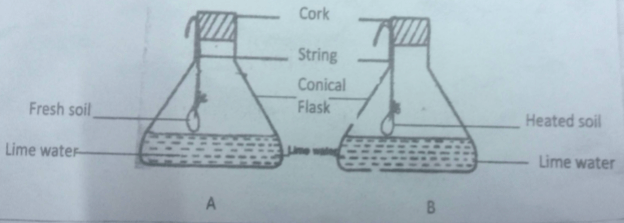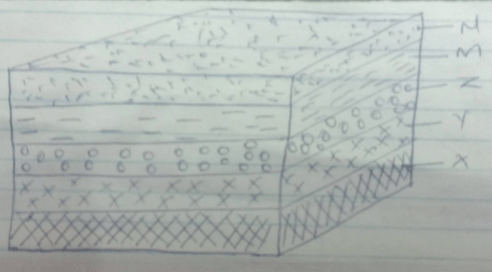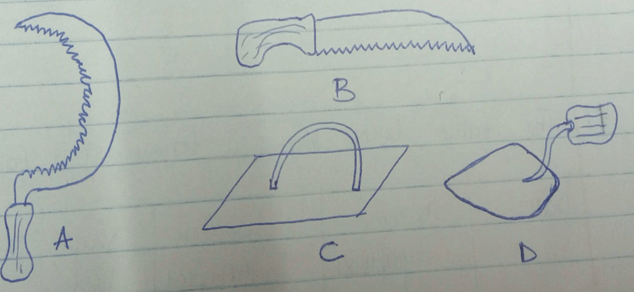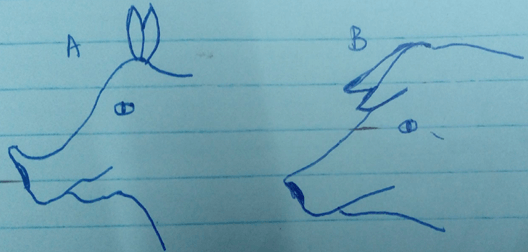INSTRUCTIONS TO CANDIDATES:
- This paper consists of three sections; A, B and C
- Answer ALL the questions in sections A, B and C.
- All answers to be written in English
SECTION A: 40 MARKS.
ANSWER ALL QUESTIONS IN THE SPACES PROVIDED.
- Give four reasons why agriculture is important in the Kenya’s economy. (4 mks)
- Differentiate between floriculture and pomoculture as used in horticultural farming. (1 mk)
- Name a chemical used to achieve the following during water treatment.
- Killing pathogens (1 mk)
- Softening water (1 mk)
- Coagulation of solid particles (1 mk)
- What is organic farming? (1 mk)
- Mention three aspects of rainfall that influence the choice of crops grown in an area. (3 mks)
- Describe the uses of various tools a farmer would use to construct a barbed wire fence. (5 mks)
- Give reasons why burning is discouraged as a method of land clearing. (4 mks)
-
- Name four types of pumps used in the farm (4 mks)
- State three features of plastic water pipes a farmer should consider when buying. (3 mks)
- Describe four characteristics of a fertile soil. (4 mks)
- Give four benefits of good soil aeration. (4 mks)
- State four physical characteristics of good dairy cow for breeding. (4 mks)
SECTION B: 30 MARKS
ANSWER ALLL QUESTIONS IN THE SPACES PROVIDED.
- A student set up an experiment to determine a certain aspect of soil

- What was the aim of the experiment? (1 mk)
- What are the expected results at the end of the experiment in A and B (2 mks)
- Explain the results in both A and B. (2 mks)
- The diagram below shows a method of drainage.

- Identify the method of drainage shown in the diagram. (1 mk)
- Name the parts labeled A and B. (2 mks)
- Give four importance of drainage in agricultural production. (2 mks)
- The diagram below shows a composite heap. Study it carefully and answer questions that follow.

- Name the parts labeled
- X
- Y
- Z
- Give the importance of adding M and N when preparing composite manure. (2 mks)
- Explain the use of a long sharp pointed stick driven into the heap. (1 mk)
- Name the parts labeled
- Diagrams A, B, C and D represents some farm tools.

- Identify the tools
- A
- B
- C
- D
- Give the use of tools B and C (2 mks)
- B
- C
- Describe two maintenance practices that should be carried out on tool A. (2 mks)
- Identify the tools
- The diagrams below illustrate pig breeds.

- Identify the pig breeds A and B. (2 mks)
- A
- B
- State the outstanding physical characteristics of pig breeds A and B. (2 mks)
- Identify the pig breeds A and B. (2 mks)
- The table below shows a format of a record.
Date Disease symptom Livestock affected Drugs used Cost of treatment Remarks - Name the farm record illustrated above. (1 mk)
- Give three uses of the farm record shown above. (3 mks)
SECTION C: 30 MARKS
ANSWER ALL QUESTIONS IN THE SPACES PROVIDED
-
- Give five problems associated with shifting cultivation. (5 mks)
- Describe environmental conditions that may lead to low crop yield (6 mks)
- Give four reasons for preparing a seedbed before planting. (4 mks)
-
- Give five uses of water in the farm. (5 mks)
- Describe the agricultural practices that cause water pollution (5 mks)
- Describe the reasons for adding organic matter in the soil. (5 mks)

MARKING SCHEME
- Give four reasons why agriculture is important in the Kenya’s economy. (4 mks)
- Source of food
- Source of employment
- Source of raw materials for agro – based industries
- Provision of foreign exchange
- Source of capital through taxation of farmers and other related organizations
- Promotion of international relations through exports and imports of agricultural goods (4X1=4 mks)
- Differentiate between floriculture and pomoculture as used in horticultural farming. (1 mk)
- Floriculture – growing of flowers
- Pomoculture – growing of fruits (1X1=1mk; mark as whole)
- Name a chemical used to achieve the following during water treatment.
- Killing pathogens (1 mk)
- Chlorine (1X1=1mk)
- Softening water (1 mk)
- Soda ash (1X1=1mk)
- Coagulation of solid particles (1 mk)
- Alum (1X1=1mk)
- Killing pathogens (1 mk)
- What is organic farming? (1 mk)
- Farming where crops are grown and livestock reared without use of agrochemicals (1X1=1mk)
- Mention three aspects of rainfall that influence the choice of crops grown in an area. (3 mks
- Reliability
- Amount
- Distribution
- Intensity (3X1 = 3mks)
- Describe the uses of various tools a farmer would use to construct a barbed wire fence. (5 mks)
- Hand saw / bow saw – cutting barbed wire
- Hole digger / soil auger – making holes for fencing posts
- Claw hammer – diving in nails
- Spade/shovel – concrete mixing
- Plumb bob – checking on the verticalness of the posts
- Mallet – driving wood chisel (5X1=5mks)
- Give reasons why burning is discouraged as a method of land clearing. (4 mks)
- Destroys soil organic matter
- Kills soil living organisms
- Leads to loss of soil moisture
- Destroys plant nutrients
- Causes mineral imbalance through ash accumulation
- Leads to soil erosion (4X1= 4 mks)
-
- Name four types of pumps used in the farm (4 mks)
- Centrifugal / rotor dynamic
- Piston / reciprocating
- Semi rotary
- Hydram (4X1 =4mks)
- State three features of plastic water pipes a farmer should consider when buying. (3 mks)
- Durability
- Color
- Flexibility
- Workability (3X1 = 3mks)
- Name four types of pumps used in the farm (4 mks)
- Describe four characteristics of a fertile soil. (4 mks)
- Good water holding capacity
- Correct soil PH relation to the crop grown
- Have essential elements in the right proportions
- Well aerated
- Free from excess soil borne pests and diseases
- Have proper drainage
- Give four benefits of good soil aeration. (4 mks)
- Improves microbial activities
- Provides the oxygen necessary for respiration by roots
- Provides the oxygen required by nitrogen fixing bacteria
- Improves the general performance of a crop
- Makes soil less toxic because of efficient gaseous exchange. (1X4=4mk)
- State four physical characteristics of good dairy cow for breeding. (4 mks)
- Straight top line
- Wedge shaped
- Well set hind quarters
- Large and well developed udder
- Large stomach
- Less fresh
- Prominent milk veins (4X1=4 mks)
SECTION B: 30 MARKS
ANSWER ALLL QUESTIONS IN THE SPACES PROVIDED.
- A student set up an experiment to determine a certain aspect of soil
- What was the aim of the experiment? (1 mk)
- To show presence of living organisms in the soil (1X1=1mk)
- What are the expected results at the end of the experiment in A and B (2 mks)
- The lime water remained clear (1X1=1mk)
- Explain the results in both A and B. (2 mks)
- A – The living organisms in the fresh soil respired and produced carbon IV oxide which turns lime water milky (1X1=1mk)
- B – the living organisms in B were killed when the soil was heated therefore no respiration occurred and no carbon IV oxide was released. (1X1=1mk)
- What was the aim of the experiment? (1 mk)
- The diagram below shows a method of drainage.
- Identify the method of drainage shown in the diagram. (1 mk)
- Use of cambered beds (1X1=1mk)
- Name the parts labeled A and B. (2 mks)
- A – Raised bed (1X1=1mk)
- B – Furrow (1X1=1mk)
- Give four importance of drainage in agricultural production. (2 mks)
- To remove toxic substances
- To reduce soil erosion
- To increase microbial activities
- To raise the soil temperature
- To increase the soil volume
- To increase soil aeration (4X ½ = 2mks)
- Identify the method of drainage shown in the diagram. (1 mk)
- The diagram below shows a composite heap. Study it carefully and answer questions that follow.
- Name the parts labeled
- X – maize stalk forming foundation
- Y – grass, leaves, refuse etc
- Z – manure (3X1=3mks)
- Give the importance of adding M and N when preparing composite manure. (2 mks)
- M – to improve the level of phosphorus and potassium in resulting manure
- N – it introduces micro – organisms necessary for the decomposition of the organic materials (2X1=2mks)
- Explain the use of a long sharp pointed stick driven into the heap. (1 mk)
- Used for checking temperatures within the heap from time to time so as to maintain the correct temperature (1X1=1mk)
- Name the parts labeled
- Diagrams A, B, C and D represent some farm tools.
- Identify the tools
- A – sickle
- B – pruning saw
- C – steel float
- D – mason’s trowel (4X ½ = 2mks)
- Give the use of tools B and C (2 mks)
- B – for pruning the hard branches of coffee (1X1=1mk)
- C – for spreading screed over floors/walls (1X1=1mk)
- Describe two maintenance practices that should be carried out on tool A. (2 mks)
Tool A- straighten the blade when bent
- Sharpen the teeth when blunt
- Teeth setting (2X1=2mks)
- Identify the tools
- The diagrams below illustrate pig breeds.
- Identify the pig breeds A and B. (2 mks)
- A – large white (1X1=1mk)
- B – landrace (1X1=1mk)
- State the outstanding physical characteristics of pig breeds A and B. (2 mks)
(1X1=1mk) (1X1=1mk)Pig breed A Pig breed B Has upright ears Dropping ears Slight dished snout Dished snout
- Identify the pig breeds A and B. (2 mks)
- The table below shows a format of a record.
- Name the farm record illustrated above. (1 mk)
- Health record (1X1=1mk)
- Give three uses of the farm record shown above. (3 mks)
- Used during selection and culling of animals on health grounds
- Help in calculation of treatment cost
- They show the course of action to be taken in maintenance of health, e.g. when to carry out vaccination. (3X1=3mks)
- Name the farm record illustrated above. (1 mk)
SECTION C : 30 MARKS
ANSWER ALL QUESTIONS IN THE SPACES PROVIDED
-
- Give five problems associated with shifting cultivation. (5 mks)
- Difficult to provide the farmer with extension services
- Poor soil and water conservation measures
- Farmer cannot have permanent projects on the land
- Low yields per unit area are obtained
- Cannot be carried out in areas of high population density
- A lot of time is wasted in movement and building new farm structures
- Farmer has no incentives to improve land and conserve soil as he has no title deed. (5X1 = 5mks)
- Describe environmental conditions that may lead to low crop yield (6 mks)
- Heavy rainfall causes lodging of crops and soil erosion
- Strong winds cause soil erosion
- Extreme temperatures causes wilting and drying of crops
- Light of high intensity causes stomata to open hence increasing the rate of transpiration and wilting in crops\Crop pests lower the quality and quantity of farm produce
- Poor soils have fewer nutrients needed for crop growth. (6X1=6 mks)
- Give four reasons for preparing a seedbed before planting. (4 mks)
- To kill weeds
- To make planting easy
- To improve soil aeration
- To improve water infiltration
- To expose soil – borne pests to the heat of the sun and to predators like birds
- For proper root penetration. (4X1=4mks)
- Give five problems associated with shifting cultivation. (5 mks)
-
- Give five uses of water in the farm. (5 mks)
- Diluting chemicals e.g. pesticides
- Watering livestock
- Processing of farm produce like coffee
- Cooling farm machinery e.g. tractors
- Rearing fish in fish ponds
- Irrigation
- Cleaning farm tools, equipment and structures like pig house, etc (5X1=5mks)
- Describe the agricultural practices that cause water pollution (5 mks)
- Use of inorganic fertilizers
- Use of pesticides
- Over cultivation
- Overgrazing due to overstocking
- Cultivation along the river banks
- Watering livestock directly in rivers (5X1=5mks)
- Describe the reasons for adding organic matter in the soil. (5 mks)
- Release plant nutrients after decomposition
- Moderates soil PH
- Increases microbial activities e.g. decomposition
- Improves soil structure by binding soil particles together
- Improves soil water holding capacity of soil due to its spongy and colloidal nature
- Improves soil aeration through improvement of the soil structure.(5X1=5 mks)
- Give five uses of water in the farm. (5 mks)
Download Agriculture Questions and Answers - Form 2 Mid Term 1 Exams 2023.
Tap Here to Download for 50/-
Get on WhatsApp for 50/-
Why download?
- ✔ To read offline at any time.
- ✔ To Print at your convenience
- ✔ Share Easily with Friends / Students

